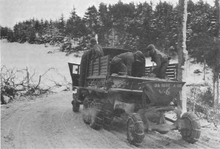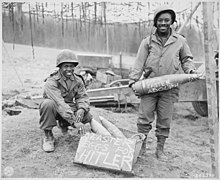User:Hawkeye7/Sandbox6
Replacing casualties[edit]
Limiting the US Army to 89 divisions meant that in the ETO divisions had to remain in the line for long periods of time, maintained at full strength by replacements.[1] American battle casualties in the November fighting were much greater than anticipated, and there was a higher rate of nonbattle casualties as well, largely as a result of cold injury such as trench foot and frostbite. In 1944–1945, there were 71,038 cold injury cases in the American forces in the ETO,[2] compared to 206 cases in the British and Canadian armies.[3] Both battle and nonbattle casualties fell disproportionately on the infantry branch, who accounted for an estimated 80 percent of them.[4] The War Department said it could not supply enough replacements from the United States, and that the theater would run out of infantry replacements if casualties were as high in December. In fact, they were even higher, due to the German Ardennes offensive.[4] Bradley was disturbed at the number of infantry replacements being sent to the Pacific, where the need was also acute. "Don't they realize", he asked Eisenhower rhetorically, "that we can still lose this war in Europe?".[5]

Casualties were replaced on an individual basis. Replacements often lost proficiency while en route or waiting for an assignment at replacement depots. Some had difficulty assimilating into their new units, as battle-hardened soldiers became wary of even learning the names of replacements because through inexperience they were a danger to themselves and others, and too often soon became casualties, beginning the cycle anew. Historians like Stephen Ambrose criticized the Army's replacement policy as inefficient, wasteful, and a cause of unnecessary loss of life. Some divisions implemented an unofficial policy of holding back replacements until the division was out of the line, or at least there was a break in combat activity, so replacements could be assimilated in a less stressful and dangerous environment.[6]
By 1945, nearly 40 percent of replacements were "casuals"—men who had already become casualties and had been processed by the medical system. These men were generally anxious to return to their units, and commanders wanted to have them back, but this conflicted with ETO policy, as it would have resulted in overstrengths in some units and shortages in others. Unofficially, replacement depots attempted to return men to their old units, but this was not always possible. In January 1945, Devers prevailed on SHAEF to authorize the automatic return of casuals to their old units in the 6th Army Group, and later in that month this was extended to the 12th Army Group as well.[7] That same month, to address problems with the replacement system, the chief of Army Ground Forces in the United States, General Joseph W. Stilwell, instituted a new policy whereby all replacements, including casuals, were formed into four-man groups who would train, travel, and fight together.[7][8]
| Month | Battle | Nonbattle | Total |
|---|---|---|---|
| July 1944 | 51,424 | 12,000 | 63,424 |
| August 1944 | 42,535 | 16,968 | 59,503 |
| September 1944 | 42,183 | 20,996 | 63,179 |
| October 1944 | 31,617 | 28,364 | 59,981 |
| November 1944 | 62,437 | 56,261 | 118,698 |
| December 1944 | 77,726 | 56,695 | 134,421 |
| January 1945 | 69,119 | 67,628 | 136,747 |
| February 1945 | 39,414 | 52,131 | 91,545 |
| March 1945 | 53,209 | 47,947 | 101,156 |
| April 1945 | 41,058 | 46,151 | 87,209 |
| 1–8 May 1945 | 2,028 | 12,150 | 14,178 |
| Total | 512,750 | 417,291 | 930,041 |
One source of additional infantry replacements was infantry serving in the Communications Zone. There were three infantry regiments (the 29th, 118th and 156th Infantry Regiments) assigned to the Communications Zone for guard duties. A program was initiated in early December 1944 under which sixty percent of their personnel were to be given three weeks' refresher training and released into the replacement stream. A similar twelve-week training course was instituted to retrain replacements for other branches and services as infantry. In January 1945, as the situation became dire, the three weeks of retraining for men released from the three infantry regiments was reduced to one, and the retraining for other branches was shortened to four weeks.[4]
On 26 December, SHAEF put out a theater-wide appeal for volunteers to join the infantry. Among those who did so were 4,562 African American soldiers, many of whom accepted a reduction in rank in order to qualify,[10] as only privates were eligible.[11] The Army remained racially segregated, and they were used to form fifty-three infantry platoons. In the 12th Army Group platoons were assigned in groups of three to infantry divisions, which attached one to each regiment, where they became a fourth platoon of one of the companies.[12] In the 6th Army Group they were formed into four companies and assigned to the 12th and 14th Armored Divisions.[13] SHAEF announced that all physically qualified men serving in noncombat units were eligible for retraining as infantry except for combat medics and those with highly specialized skills. On 1 January 1945, Lee assigned quotas to the COMZ sections to provide 21,000 men over the following five weeks. The War Department was asked to provide 25,000 limited service men to replace them.[14]

Casualties remained high in January,[15] but by March the measures taken to address the replacement shortage began to have an effect, and casualties, while still high, were lower than anticipated, so a surplus of infantry replacements began to accumulate. By April, there was an excess of 50,000 infantrymen in the replacement system. Partially retrained infantrymen were assigned to military police, anti-aircraft and heavy artillery units used to guard POWs and control displaced persons, and the War Department decided to divert 19,000 infantry replacements, scheduled for shipment to Europe in May, to the Pacific.[16]
Meanwhile, a shortage of 20,000 men developed in the other arms and services. The ADSEC commander, Brigadier General Ewart G. Plank reported that his white units were understrength by an average of 16 percent, and some by as much as 34 percent.[16] There was little hope that additional service troops could be provided. Shortages of service personnel were addressed through greater utilization of civilians and POWs.[17] About 49,000 men were transferred from COMZ between 1 February and 30 April, when SHAEF suspended the program. About half of them completed their retraining before the war in Europe ended on 8 May.[18]
- ^ Matloff 1960, p. 378.
- ^ Whayne & DeBakey 1984, p. 494.
- ^ Whayne & DeBakey 1984, p. 198.
- ^ a b c Ruppenthal 1959, pp. 316–321.
- ^ Bradley 1951, p. 447.
- ^ Vento, Carol Schultz (12 April 2012). "The U.S. World War II Troop Replacement Policy". Defense Media Network. Archived from the original on 24 August 2023. Retrieved 30 July 2023.
- ^ a b Ruppenthal 1959, pp. 343–344.
- ^ Lerwill 1954, p. 303.
- ^ Ruppenthal 1959, p. 317.
- ^ Lee 1966, pp. 688–693.
- ^ Ruppenthal 1959, pp. 322–323.
- ^ Lee 1966, pp. 693–695.
- ^ Lee 1966, p. 699.
- ^ Ruppenthal 1959, pp. 329–330.
- ^ Ruppenthal 1959, pp. 332–333.
- ^ a b Ruppenthal 1959, pp. 460–464.
- ^ Ruppenthal 1959, pp. 296–297.
- ^ Ruppenthal 1959, p. 467.
